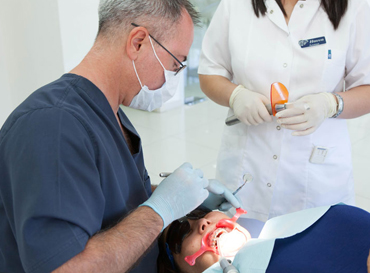

Address:
Bahar Street No:9 Yenikent, Gönyeli
Contact Us
+90 392 22 38759 - 22 38760

An orthodontist is a specialist in the diagnosis, prevention and treatment of dental and facial irregularities. All orthodontists are dentists, but only about six percent of dentists are orthodontists. Admission to orthodontic post-graduate programs is extremely competitive and selective.
It takes many years to become an orthodontist and the educational requirements are demanding.
An orthodontist must complete college requirements before starting a three- to five-year graduate program at a dental school accredited by the American Dental Association (ADA). Af ter dental school, at least two or three academic years of advanced specialty education in an ADA-accredited orthodontic program are required to be an orthodontist. The program includes advanced educatian in biomedical, behavioral and basic sciences. The orthodontic student learns the complex skills required to manage tooth movement (orthodontics) and guide facial development (dentofacial orthopedics).
Only dentists who have successfully completed these advanced specialty education programs may call themselves orthodontists.
Orthodontists are dental specialists who diagnose, prevent and treat dental and facial irregularities. They receive an additional two to three years of specialized education beyond dental school to leam the proper way to align and straighten teeth..



As a parent, you want the best for your child. That includes healthy teeth and a pleasing smile. Start with regular dental care.
The American Dental Association recommends that a child visit the family dentist by his or her first birthday,
while baby (primary) teeth are emerging. Your dentist can alert you to any concerns about how the teeth and jaws are developing.
Give Your Child the Gift of a Healthy Smile
Not only do well-aligned teeth look good and feel good, they also are important to good dental health. Poorly aligned teeth can lead to dental problems. Not everyone needs orthodontic treatment.
But if your child does need help, it pays to start treatment when you have the greatest chance for success. Make sure your child receives an orthodontic check-up no later than age 7.
All Kids Should Get an Orthodontic Check-Up No later Than Age 7
To have a smile that's good for life, your child needs teeth and jaws that are properly aligned - in other words, a healthy bite. The American Association of Orthodontists recommends that your child get an orthodontic check-up no later than age 7.
By then, your child's teeth have developed enough to where subtle problems can be spotted with jaw growth and emerging teeth.
"No Later Than Age 7"
While orthodontic treatment most often begins between the ages of 9 and 14, some orthodontic problems are easier to correct if they're treated early. If it appears that treatment will be needed, your orthodontist can advise you as to the ideal time to begin. This gives your orthodontist the best chance to:
Signs the Bite's Not Right
It's not always easy to tell when your child has an orthodontic problem. Even teeth that look straight may be hiding a problem bite. Here are some clues that may indicate the need for orthodontic attention:
Healthy
Not only do well-allgned teeth look good, they're good for you, too. Straight,well-aligned teeth are easier to clean and maintain.
And, well-aligned teeth can help you avoid such problems as abnormal wear of tooth surfaces, difficulty in chewing and/or speaking,
and excess stress on supporting bone and gum tissue. Your teeth will be with you all your life. Why not do your best to ensure they're strong and healthy?
Beautiful
Smiles come in many shapes and sizes. what's yours?
A pleasing smile can be a big plus for you on the road of life. It engages others, and shares warmth. Orthodontics can help bring out the best in you. By applying the science of gently moving teeth,
an orthodontist can help to eliminate gaps between your teeth, straighten crooked teeth and correct other problems that can be distracting when you're interacting with others.
The before-and-after work of an orthodontist is amazing. The orthodontist will work with your existing teeth and jaws so their natural beauty can come out
Look Good and Feel Good
You want to get the most from life, to achieve your goals, your dreams. You want to look good and feel good. Every day, your smile is there for the world to see.
lt's the window between you and the world. But if you 're one of the many people who have teeth that don't line up correctly, you may be self-conscious about your smile. Misaligned teeth also can cause various dental health problems.
Fortunately, many of these problems can be resolved through orthodontics . What can orthodontics do for you?
Keeping your smile beautiful
The responsibility is yours. The fact is that you are the person in charge of keeping your teeth straight. How do you do this? By wearing your retainers. Retainers are used for two reasons: first,
to allow bone to rebuild after your teeth have moved, and second, to keep individual teeth from drifting. In other words, retainers preserve and stabilize the results you and your orthodontist achieved through your orthodontic treatment.
There are many types and designs of both uper and lower retainers.Your orthodontist has prescribed custom retainers that are best for you. But retainers can only do their jobs if you do yours by wearing them as instructed by your orthodontist.